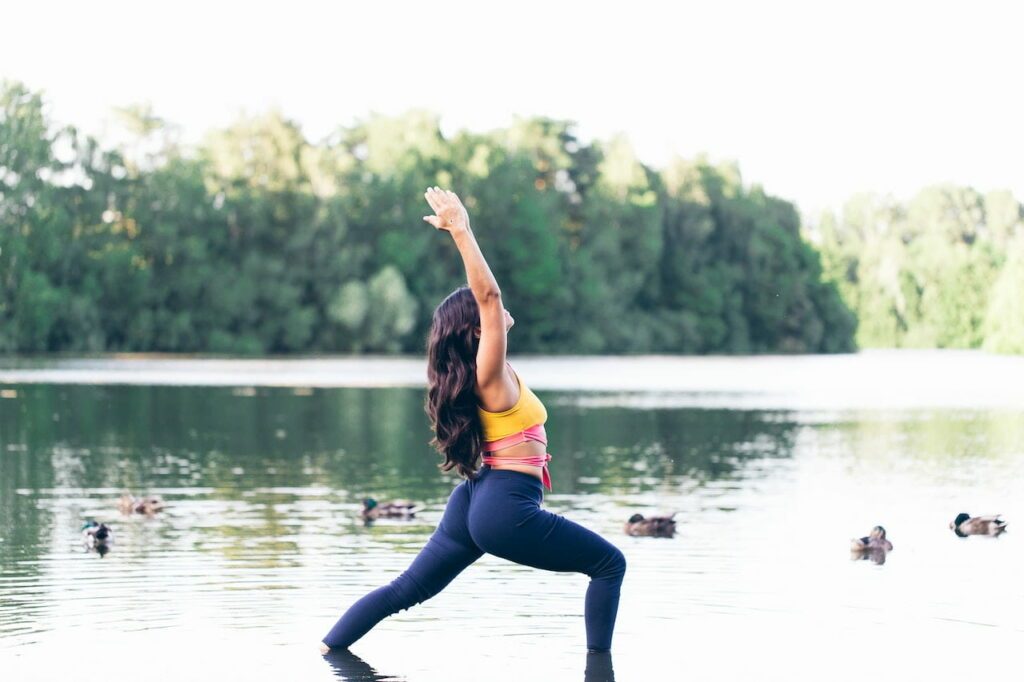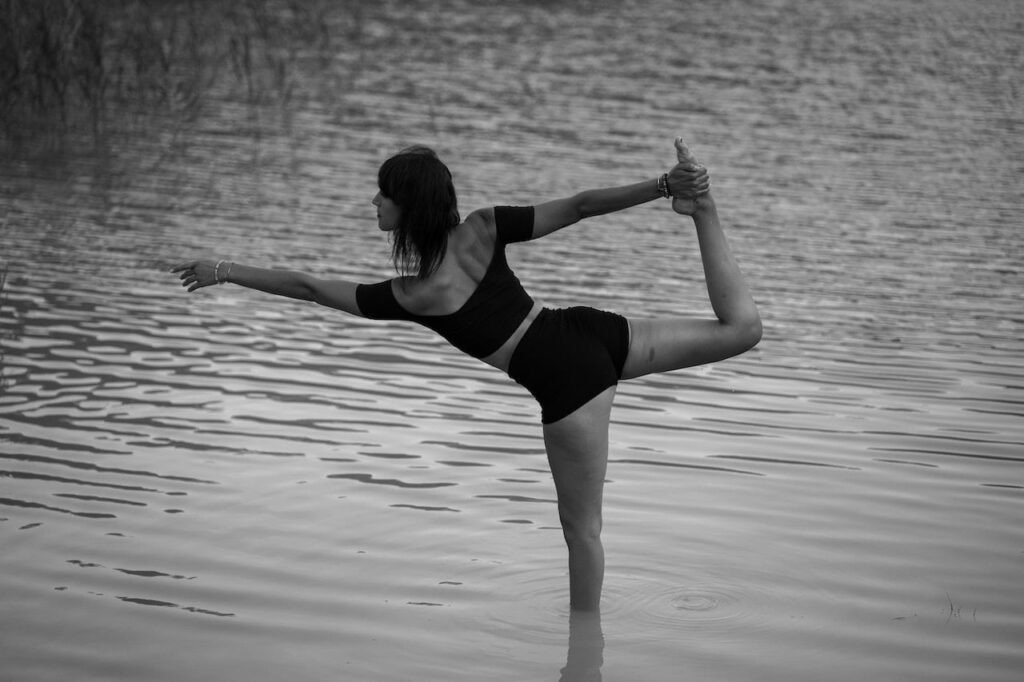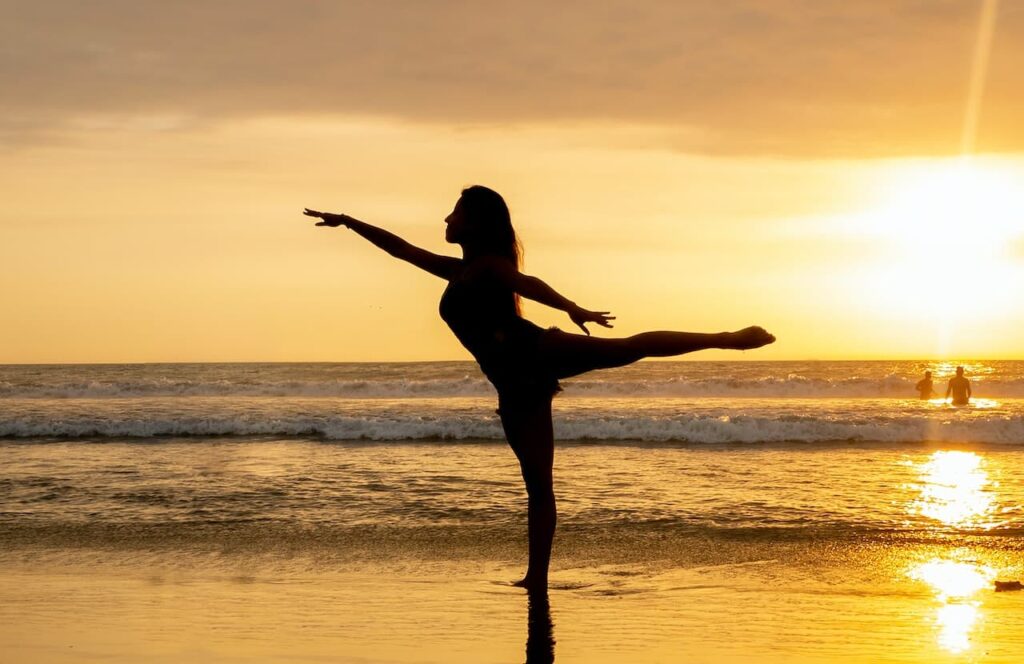Find out how to incorporate Pilates into the office to improve your well-being and productivity with simple exercises.
Menu

Accueil » Accueil » Yoga forms » Aqua yoga: the art of mixing water and the body for total serenity
A desire to swim but also to improve your physical health? It's time for you to take the plunge with theaqua yoga ! Its interesting formula mixes traditional yoga postures and connection with nature. Accessible to all, enjoy a activity gentle et fortifying to soothe your body and mind.
Yoga blends with the aquatic element to form aqua yoga, this discipline which continues to gain followers! This fusion draws its sources from ancient and modern practices to give birth to this new formula for well-being. But then why did you choose the element of water and do the postures change? This is what we will see in the rest of this article.
Aqua yoga dates back thousands of years, when ancestral civilizations recognized the benefits water on the well-being and the healing. Particularly in Indian and Greek cultures where thewater served as ritual of purification and of regeneration. Indeed, in these societies, thermal and ritual baths were very widespread because water was considered a sacred element with healing properties.
Then, in the 1990s, aqua yoga was developed in Florida, United States. This combination was born from a team of yoga instructors who sought to offer a therapeutic alternative to practitioners with physical limitations. That is why, the water seemed to be a good solution due to its resistance which allows yogis to work on their bodies without restraint for the muscles and the joints.

Traditional yoga and aqua yoga have two different approaches to the same ambition: cultivating harmony of body and mind. Within this spectrum there remain significant differences which we will examine together.
The first big difference is the environment in which yoga is practiced. Indeed, generally, traditional yoga is practiced on a yoga mat in a calm and soothing atmosphere like yoga studios featuring soft music in the background. Sometimes yoga can be done outside, such as a park, in which case practitioners seek to get closer to nature. Furthermore, the classic environment encourages focus on breathing and self-awareness so that the yogis are detached from the outside world and can focus on the present moment.
Like traditional yoga, aqua yoga takes place in a swimming pool, lake, hot spring or ocean, water is seen as an element that adds soothing and therapeutic dimension to practice. Then, the water allows participants to float, making movement easier and reducing impact on muscles and joints. But the resistance of the water forces practitioners to do work the muscles to maintain postures, which strengthens their stability and their balance.
Another significant difference between these two forms lies in the resistance exerted on the body. Let's take traditional yoga as an example, the resistance mainly comes from the gravity and some muscle tension. Indeed, postures must be maintained for prolonged periods, which forces the muscles to work to support the body in the various positions. Furthermore, the resistance is static. That is to say, the postures are maintained for a certain duration.
Concerning the effects on the body, traditional yoga uses all the muscle groups of the body. Therefore, the strength, there flexibility et endurance are developed and joint health is maintained. From this follows a reduction of muscle and joint pain as well as release of tension. In addition, traditional yoga allows a better self-awareness and its breathing.
In aqua yoga, resistance is created by the water, which provides a low impact environment. Furthermore, postures in the water force the body to work against the resistance of the water to maintain a stability and one balance. Indeed, movements in water require more muscular effort than on land.
In terms of effects on the body, as previously said, water requires more physical effort, which builds endurance and muscle strength. In addition, fluid movements promote better flexibility without putting pressure on the joints and deep relaxation. Finally, flotation and hydrostatic pressure have an effect soothing on the body releasing muscle tension.
Traditional yoga emphasizes stability et the balance in each posture. First of all, it is essential to have a solid foundation. Particularly at the feet, hands and knees since these parts of the body serve as support. This is what allows the body to expand and balance. Finally, balance in traditional yoga also depends on the concentration and some self-consciousness.
In aqua yoga, water reveals a natural resistance in all directions, which means that each muscle must work in harmony to maintain balance. Something which is not obvious since water is unstable and asks for a constant adaptability to find and maintain balance. Finally, aqua yoga requires a coordination increased to perform the movements.
Relaxation in traditional yoga is mainly achieved through a key element: savasana posture. This is a relaxation posture lying on your back, arms alongside the body and legs relaxed with your eyes closed. Then, there is another method to relax, it is the conscious meditation where mindfulness is activated and attention is focused on breathing while letting thoughts pass. After this exercise the mind is calmed and only the present moment counts. Then, the studios yoga shoes are designed to be soothing. The music playing there as well as the smell and decoration help practitioners to relax and concentrate on relaxation.
Aqua yoga produces a floating effect which allows yogis to relax and feel lighter. Indeed, flotation helps to release muscle tension, which promotes deep relaxation. Additionally, the practice offers a connection with water, which gives a calming effect on the body and mind. Finally, meditation can be done in movement. That is to say that practitioners can relax by letting themselves be carried away by the movements of the water.
Generally, traditional yoga is accessible to a wide range of people but certain positions can represent real challenges for some of them. Indeed, some postures may vary depending on intensity and can become demanding physically. Some people, especially beginners and people with physical limitations, may find them difficult to perform. However, instructors are trained to provide modifications to postures or alternatives to allow everyone to participate.
Furthermore, traditional yoga offers a wide variety of practice levels to meet everyone's needs. For example, there are courses specifically for beginner, intermediate and advanced. In this sense, practitioners can progress at their own pace by ensuring they have acquired the basic postures before moving on to advanced postures.
Aqua yoga is more accessible due to the aquatic environment which is suitable for people with physical limitations. Like traditional yoga, aqua yoga is accessible to all levels, from novice to experienced. For example, beginners can start with simple positions and progress to complex movements if they feel comfortable.
By practicing in water, yoga postures take on a new dimension combining stability and fluidity. To illustrate the point, here are some common aquatic yoga postures.
To perform mountain pose, stand with your feet together and your arms at your sides. Next, activate the core muscles by gently contracting your abdominals and slightly lifting the pelvic floor. Then, breathe deeply, focusing on each inhalation and exhalation. Then, stay in this posture for as long as you are comfortable in the water.
To reproduce this posture, hold on to the edge of the pool or place your foot on the knee of the other leg. Next, you can engage your body stabilizer muscles by contracting your abdomen. Take a deep breath and lower your foot back to a standing position. Finally, repeat the operation on the other leg.
To begin, stand with your feet together. Next, extend your arms out to the sides. Continue by taking a step back with your right leg, keeping your feet hip-width apart. When performing this gesture, the toes of your right foot should be turned slightly outward while your left foot points forward. With this, bend your left knee to 90°, engaging your core muscles. Finish by taking a deep breath and hold the position for as long as you are comfortable. Then repeat the exercise on the other side.
To begin, lie on your stomach in the water with your feet together and toes extended. Next, place your hands under your shoulders, palms down and fingers pointing up. While inhaling, gently lift your chest using your back muscles. With that, lift your upper body and open your chest by tilting your head back slightly. Finally, hold the posture for as long as suits you.
Kneel in the water then sit back on your heels. Continue by stretching your palms towards the bottom of the water After which, slowly lower your torso forward, between your knees. Finally, you can stay like this for as long as you want.
Aqua yoga is a holistic practice that combines the benefits of traditional yoga and those of water. here are some benefits aqua yoga:

Aqua yoga began in Florida in the 1990s by yoga instructors. The goal is to combine the benefits of yoga and water. But then what are the changes between yoga on land and aqua yoga? Here they are :
Then we saw some postures present in aqua yoga such as:
Finally, we reviewed the profits What does aqua yoga produce:
What if you came back to earth to relax at POSES ? Swap your bath towel for a sports towel. Direction POSES to experience a dynamic yoga experience that is both intense and relaxing.
Curious to know what's in store for you? Those are 50 minute sessions where the yoga postures, transitions and movements are defined. But that's not all ! You will have the opportunity to discover the Pulse® sequences that will work your body from head to toe. At the meeting of bodyweight exercises, isometrics and muscle strengthening plunged into darkness with dim light.
Need advice? Our coaches are there to answer you and give you the solution best suited to your problem.
Convinced to put your feet back on the ground with POSES?
studios
POSES Studio Paris – Yoga, Pilates, Barre
21 Rue des Filles du Calvaire, 75003 Paris
POSES Studios
6 rue de l’échquier, 75010 Paris
studios
POSES Studio Paris – Yoga, Pilates, Barre
21 Rue des Filles du Calvaire, 75003 Paris
POSES Studios
6 rue de l’échquier, 75010 Paris

welcome pack
1 session purchased = 1 free
35€
That is 26 credits which will allow you to complete at least two sessions* of your choice from among our 6 activities.
Only one purchase possible
Credits valid for 1 month after purchase
*based on 12 credits per session (85% of our sessions are worth 12 credits)

Shareable Session Pack
We know that sports are more fun with your friends, so we allow you to invite a +1 to each of your sessions.
You will have the option to book for 2 people when choosing your session in the Sanctuary App.

Shareable subscription
We know that sports are more fun with your friends, so we allow you to invite a +1 to each of your sessions.
You will have the option to book for 2 people when choosing your session in the Sanctuary App.

Postponable sessions
Sick? On vacation? Or is a busy week preventing you from completing your weekly session(s)?
No stress about losing your sessions! Sessions are carryover up to 3 weeks after the date the session is credited.
Each session credited to your account is valid for 4 weeks in total.

The credit system
The more credits you buy at a time, the lower the individual cost.

85% sessions cost 12 credits.
The number of credits required per session varies between 10 and 16 credits depending on different criteria:
With credits, you can benefit from lower rates on times with less demand.